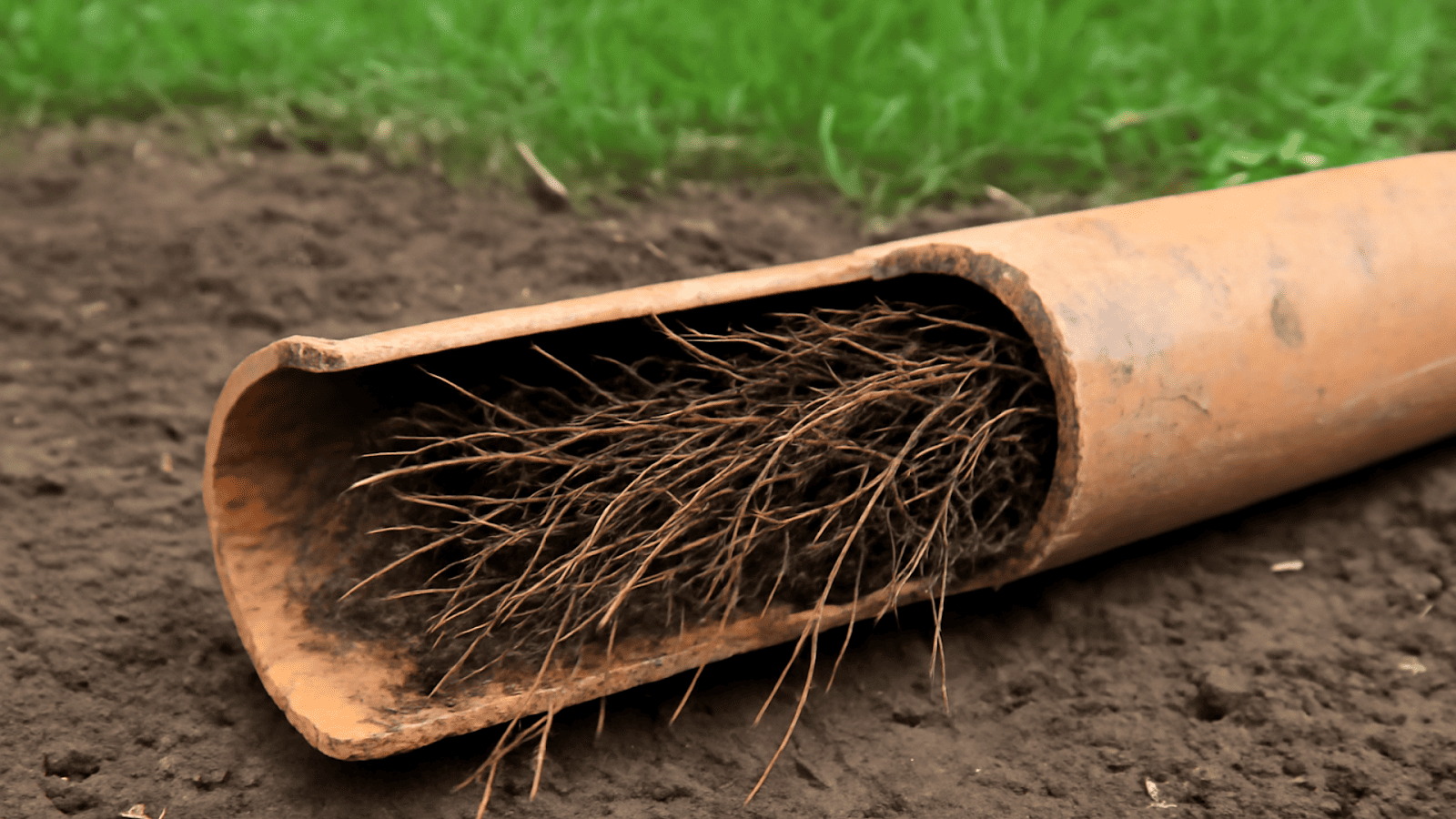In Simi Valley, where the average annual rainfall is just 17.9 inches and snowfall is rare, tree roots frequently invade plumbing pipes and sewer tanks. Unfortunately, homeowners notice the problem when big signs like sewage blockage or foundation cracking appear. Read on to learn how to spot the early signs of root intrusion and take the right action as per the severity of the damage.
Is there a foul smell lingering in your yard? Or do your toilets keep backing up every few months?
All this may sound like random homeowner issues, but it isn’t!
They’re warning signs pointing to a serious underground problem: tree roots invading your sewer or drainage lines.
Yes, you read that right — tree roots can actually grow inside your plumbing pipes. If you’re hearing this for the first time, like many homeowners, you may be wondering:
- Are roots in pipes really that common?
- How do they even get inside sealed plumbing lines?
- And more importantly — how do you stop them?
If these questions are on your mind, then you’re in the right place.
At Sketchley & Mason Plumbing, we’ve seen this problem far too often during plumbing repairs, so we bring you answers to the above questions and many more.
Let’s get started.
How Do Roots Get Into Pipes?
In dry areas like Simi Valley, tree roots are constantly searching for moisture and nutrients. Underground sewer pipes carry exactly what roots are looking for — water, oxygen, and organic matter.
Even a small crack, loose joint, or a tiny gap in an old pipe can release moisture into the surrounding soil.Â
Tree roots sense this moisture and naturally slip into the pipes. Once inside, the roots grow thicker, form tangled masses, and eventually block the flow of water.
Tree root problems won’t fix themselves – they’ll only get worse over time!
At this stage, you are probably thinking about the next steps, like:
Can I fix this myself? Will my insurance cover it?
Yes, you can fix it yourself, but involving professional plumbing services early can prevent bigger damages and future costly repairs, especially since most insurance policies don’t cover gradual damage caused by tree roots.
Keep reading to know how professionals deal with root growth in pipes, drains, and sewer lines.
What Are The Remedies For Tree Root Damage In Pipes?
The solution for root invasion in pipes can be anything from a minor repair to a complete replacement or rerouting, depending on the extent of the damage.
It’s important to choose the right approach for your situation.
Below, we’ve explained the three common levels of tree root issues — and what you can do to fix each one.
- Level 1: Highly Damaged Sewer Line
- Level 2: Early Signs of Root Growth
- Level 3: Preventive Measures
Level 1: Highly Damaged Sewer Line (Severe Blockages and Backups)
| What Are The Signs Of A Serious Root Problem? The toilet backs up into the tub or shower Many drains are clogged at once Bad smell or sewage in yard/home Big cracks or damage in pipes Dirty water flooding inside or outside |
What Are The Solutions For Severe Root Damage?
In this level, quick fixes won’t be enough. You need a permanent repair, which starts with an inspection by a professional plumber:
Full Sewer Line Repair or Replacement:
If the pipe is broken or collapsed because of roots, it will need to be dug up and replaced.
In Simi Valley, many older homes have clay or cast iron pipes, which roots can easily break into. These are usually replaced with stronger PVC or ABS pipes.
Trenchless Sewer Line Relining:
You don’t always need to dig up your yard. If the pipe isn’t fully collapsed but has cracks or root intrusion, professionals perform trenchless relining.
This process involves cleaning the pipes, inserting a resin-coated liner, inflating it to stick to the walls, and letting it harden to create a new pipe inside the old one.
Note: Clearing the clog provides only temporary relief, as roots can quickly re-enter and grow back in 6 to 12 months. A Reddit user shared a similar experience.
Level 2: Early Signs of Root Growth (Minor Damage in Early Stages)
| What Are The Signs Of A Minor Root Problem?A single slow-draining sink or tubFaint sewer smell from time to timeSmall root strands spotted during a routine checkA one-time clog that brought up tiny root pieces |
What Is The Step-By-Step Process For Minor Root Damage?
Step 1: Mechanical Root Removal (Hydro-Jetting or Snaking):
- If some roots have entered the pipe, plumbers use a power auger (drain snake) with a root-cutting blade to chop up roots inside the line. Â
- Sometimes, they also use hydro-jetting to blast high-pressure water (often 3,000+ PSI) through the pipe to shear off and flush out roots.
Step 2: Chemical Root Treatment:
After physically removing roots, plumbers apply a root-killing chemical to the pipe and flush it down the toilet or sink to the sewage lines.
This temporarily stops the root regrowth and buys you some time before the roots reappear.
| Note: Chemical treatments work best as a follow-up to mechanical clearing, not as a first line of defense! |
Step 3: Pipe Relining or Patching
If only part of the pipe is damaged, plumbers can patch that section using a liner or epoxy.
For longer areas with small cracks, full pipe relining may be used. Both methods seal entry points and help stop roots from coming back.
| Note: After Level 2 root damage treatment, make it a habit to get a yearly or biennial drain cleaning as preventative maintenance. |
Level 3: Preventive Measures (Precautionary Solutions)
An ounce of prevention is worth a pound of cure!
Level 3 is all about prevention – stopping tree roots from ever gaining a foothold in your sewer lines, so, yeah, there won’t be any signs, just these four simple tips:
- Routine Sewer Line Inspections:Â
Schedule an annual sewer line inspection, where plumbers use a small camera to detect early issues such as cracks or minor root intrusions ahead of time.
- Preventive Cleaning:
Consider hydro-jetting or snaking your sewer line yearly, especially if you have large trees nearby, to prevent root growth.Â
- Install root barriers:Â
Install a root barrier between trees and your sewer line to redirect roots away from pipes.
- Mindful Landscaping:Â Â
Avoid planting trees directly above or near sewer lines, as their roots can spread 2-3 times the canopy width and reach the pipes.
Conclusion:
Tree root damage often goes unnoticed—until it causes major clogs and costly repairs. The best defense is early detection, timely action, and smart prevention.
At Sketchley & Mason Plumbing, we’ve served Simi Valley since 1921. If you suspect roots in your sewer line or want to prevent future issues, give us a call. We’ll inspect, advise, and help protect your plumbing for the long run.
FAQ:
1. How often should I use root killer in my pipes?
Use it every 6 to 12 months, especially after mechanical clearing. It helps slow down regrowth.
2. Will insurance pay to repipe a house?
Usually not. Most homeowner insurance doesn’t cover damage from tree roots or repiping unless it was caused by a sudden, covered event.
3. How much does it cost to remove roots from drains?
On average, $200–$600 for professional root removal using a snake or hydro-jetting.
4. How serious are tree roots in a sewer line?
Very serious. They can cause blockages, pipe cracks, backups, and even total pipe collapse if left untreated.
5. How deep should a root barrier be installed?
At least 2 to 3 feet deep, depending on the tree type and soil. Some aggressive roots may require deeper placement.
6. How much does it cost to install a root barrier?
Typically $1,000–$2,500, depending on length, depth, and materials used.



